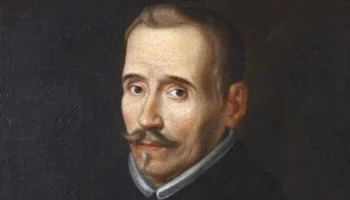“Fuenteovejuna” is a play by the Spanish playwright Félix Lope de Vega (1562-1635), published in 1619. It is considered one of the most relevant theatrical dramas of the Spanish Golden Age.
The theatrical work is divided into three acts and deals with themes of honor, collective power, and abuse of authority.
“Fuenteovejuna” is inspired by events that occurred in the municipality of Fuente Obejuna in the province of Córdoba, Andalusia, in the 15th century.
Summary of Fuenteovejuna:
After the death of King Enrique IV of Castile, Spain plunges into civil war and a dispute over Ciudad Real, a strategic point, between supporters of his sister Isabel’s succession and those backing his daughter Juana.
The Commander Fernán Gómez, supported by the Master of the Order of Calatrava, is known for his excesses and abuse towards the women of Fuenteovejuna. His persistent advances towards Laurencia, the daughter of the mayor Esteban, who repeatedly rejects him, citing obedience to him as her commander but refusing to sacrifice her honor, are particularly notable.
Meanwhile, the commander and the master conquer Ciudad Real and invite Laurencia and her friend Pascuala to the Commander’s House during the celebration, but the women resist.
Laurencia agrees to marry the farmer Frondoso after he seeks her hand from Mayor Esteban. During the wedding, the commander arrests Frondoso and kidnaps Laurencia. Amidst this situation, the Catholic Monarchs, Isabel and Fernando, gain control of Ciudad Real.
Faced with the injustice committed by the commander, the townspeople gather in the council chamber to reach a resolution. Laurencia enters, showing clear signs of struggle, and urges the men to act. Rebellion ignites, and the battalion of women is organized.
The townspeople force their way into the Commander’s house, preventing Frondoso’s hanging. They kill the commander, despite his pleas, and punish the servants who supported him.
The Catholic Monarchs learn of the events through Flores, a subject of the commander who manages to escape, and decide to send an investigator judge to examine the situation.
The investigator judge tortures an old man, a child, and a woman to extract the truth, but the people stick to their previous communal decision to respond that it was Fuenteovejuna.
The investigator judge informs the monarchs that he has not been able to find the true culprits. Therefore, there are only two solutions: either pardon or execute the entire town.
The villains go to the palace to explain to the monarchs the reasons for the murder while reaffirming their obedience to the king.
The monarchs declare, in the face of this situation, as a final judgment, that it is just to pardon the village due to lack of evidence about the true culprits, despite the heinous crime. They incorporate Fuenteovejuna into the Crown until another commander inherits it. The play ends with a celebration and praise for the king.
Characters and analysis of Fuenteovejuna:
The plot of Fuenteovejuna focuses on two fundamental aspects:
- The triangle between the commander, Laurencia, and Frondoso, with the commander being the tyrant who abuses his power by pursuing Laurencia, Frondoso being Laurencia’s boyfriend who defends her from the commander’s imminent assault, and Laurencia, who defends her honor and organizes the women’s battalion to demand justice.
- The political situation in Spain, which is divided after the death of King Enrique IV, causing a civil war between those who want the daughter of the king, Doña Juana, to succeed to the throne, and those who support Isabel of Castile, the king’s sister.
The main characters of the play are:
- Fernán Gómez de Guzmán: The commander of the Order of Calatrava known for abusing his power. He is the tyrant of the play and is eventually killed by the townspeople.
- Ortuño: The commander’s servant, tasked with bringing the women from Fuenteovejuna whom the commander pursues to the Commander’s House.
- Flores: The commander’s servant who survives the rebellion where the commander is killed and informs the monarchs about what happened.
- The Master of Calatrava: Rodrigo Téllez Girón, a noble who fights against the Catholic Monarchs in favor of Doña Juana’s succession to the throne, along with the commander.
- Pascuala: A farmer from Fuenteovejuna and Laurencia’s friend.
- Laurencia: The daughter of the mayor of Fuenteovejuna, who is harassed by the commander. Her view of love is platonic, focusing on the virtue of the beloved.
- Mengo: A farmer in Fuenteovejuna and defender of women. He defines love in Aristotelian terms, explaining that there is no love as it consists of perpetually discordant elements and that selfish love is the only one that exists.
- Barrildo: A farmer in Fuenteovejuna. He defines love in Pythagorean terms, suggesting that love is the fundamental cause of harmony in the universe.
- Frondoso: A farmer in Fuenteovejuna and Laurencia’s boyfriend.
- Juan Rojo: A farmer from Fuenteovejuna who suggests seeking the protection of the Catholic Monarchs in the town’s meeting as a solution to the incident of Frondoso’s kidnapping by the commander on the day of Frondoso and Laurencia’s wedding.
- Esteban: The mayor of the town of Fuenteovejuna and Laurencia’s father. An honest and honorable man.
- King Don Fernando: The Catholic king who rules Castile alongside Doña Isabel after winning the battle to retake Ciudad Real.
- Queen Doña Isabel: Isabel of Castile and sister of King Enrique IV. After the king’s death, she contested the throne with Enrique IV’s daughter, Doña Juana.
- The Judge: The investigator judge sent by the Catholic Monarchs to Fuenteovejuna to find the truth about the commander’s murder. To extract information, he tortures a child, an old man, and a woman in Fuenteovejuna.
